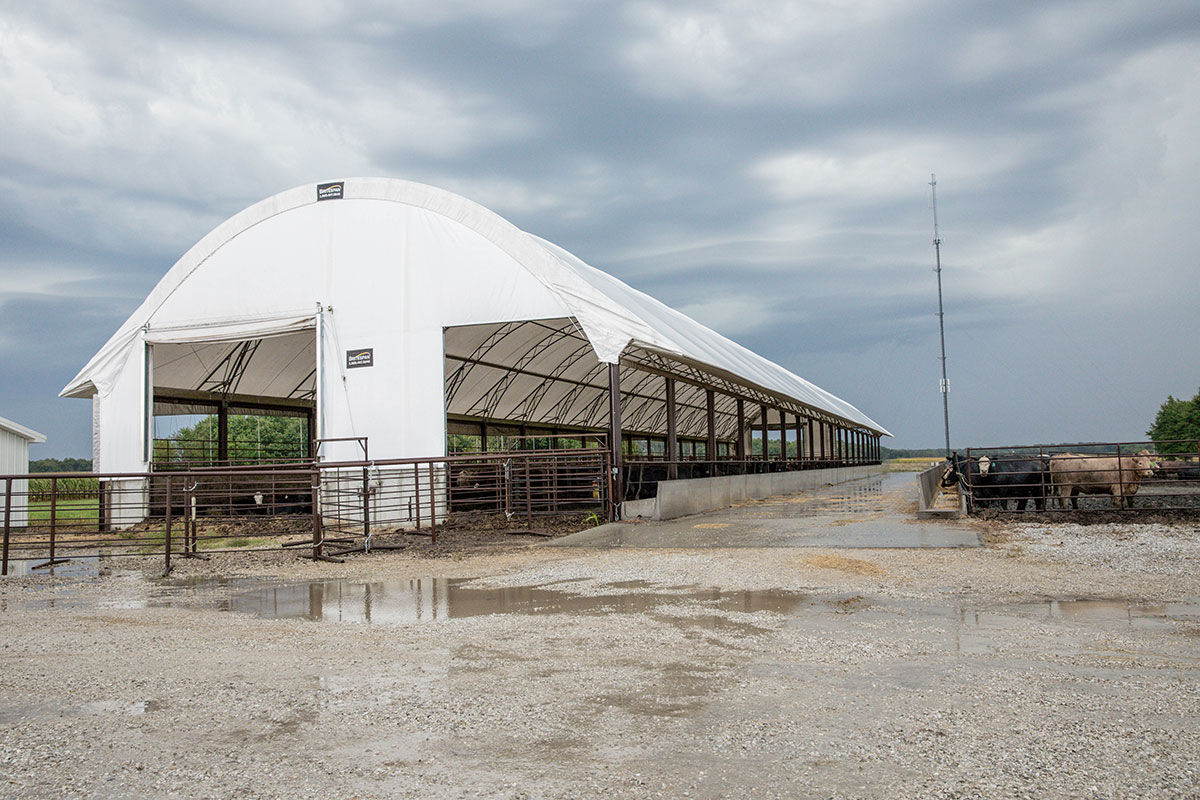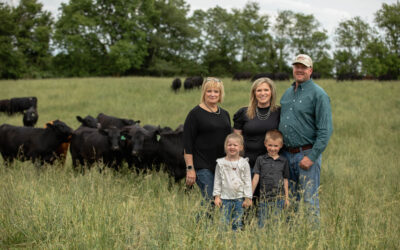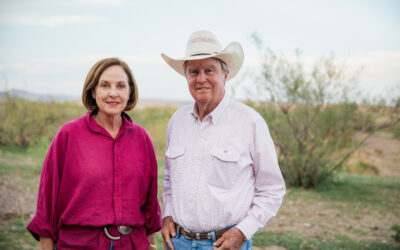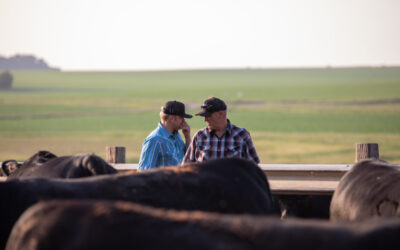
Proven but still improving
Gray skies or blue, Angus genetics shine for Missouri family
By: Morgan Marley
Thunder rolls across northeast Missouri as the morning storm clouds darken. Hard rain begins pelting the ground and the backs of cattle lined up for breakfast. It’s not an unusual start for a day where 39 inches of rain fall each year.
Far less common is a feedyard nestled into the hills. This one may not stop you as you drive by, but it’s big enough to see just south of Knox City, Mo., on Google Maps satellite view when the address only takes you to the town.
For nearly 140 years, this farm has grown cattle and grain for the Miller family.
These days, Steve Miller and his three sons each have their own operations with crops and a total of 700 commercial cows, but they work cooperatively to keep everything running smoothly. The patriarch feeds cattle in the yard every day, regardless of weather.
Brothers Bill, Chad and Russ are in charge of genetic decisions, sharing advice and honing in on the kind of cattle the family wants in their 1,500-head feedyard.
Obviously, only a portion of the fed cattle can be homegrown, so they buy some and contract with an order buyer who’s come to understand what they want and where to find them.
All agree on the merits of Angus cattle.
“We have been focusing on carcass quality,” Bill says. “The data is showing the more Angus background we can put in these things, the premiums are paying.”
Genetics that pay
He and the family debate the advantages of hybrid vigor and occasionally bring in other breeds. Currently they’re trying some Charolais and Red Angus genetics.
“We wanted to see if we can keep the quality grade and make carcasses bigger,” Bill says. “It seems like the stronger Angus genetics are still the ones paying.”
All their fed cattle sell in load lots on a value-based grid to the Tyson plant at Joslin, Ill. That’s about four hours away but of course it takes a while longer for the results in the form of data and check.
“Our straight Angus calves are showing at least twice as many Primes as other cattle,” Bill says. They appreciate the premium for hitting the Certified Angus Beef ® (CAB®) brand target, but consider CAB Prime as bullseye. “The Prime premium is two to three times more—that’s what really pays,” he says.
While they have always bred for balanced genetics with an emphasis on carcass traits, the family is relatively new to grid marketing.
After buying bulls from Brinkley Angus Ranch at Milan, Mo., for 10 years, Jim Brinkley knew the Millers’ genetics. He advised them to retain ownership through finishing to get paid for what should be high-quality carcasses.
Three years ago, they tried it.
“We thought we did extremely well,” Bill says.
It’s hard to argue with 95% CAB that included 77% Prime on their first loads. Their 300 home-raised cattle born in 2017 also beat 70% Prime, but the ’18 calves rang bells when they finished at 99% CAB with 82% Prime. In six home-raised loads, the two poorest grading cattle were low Choice.
Average genetics won’t produce those results. It took investments in time, technology and the study of expected progeny differences (EPDs).
“When we went to grow the cow herd, we decided to try the GeneMax® program,” Bill says. “It took two, three, four years to get that data built up and that is when it started showing and we knew we were on to something.”
When time and resources allow, they breed many of their cows via artificial insemination (AI). Otherwise, the Millers rely on the Angus bulls they’ve been buying. “The carcass traits seem to be working at Brinkley’s,” he says.
“Basically it seems to be the data always goes back to carcass quality and growth combined all in one,” Bill adds. “It is something that is producing—from the cows to the feedyard.”
Consumer demand for high-quality beef is strong. And when the cattle are “taken care of properly,” he says the premiums pay cattlemen and consumers get the benefit.

Covering your assets
The weather in northeast Missouri provides plenty of everything. The summers are hot. The winters are cold. And many years, like 2019, bring lots of moisture to make feedyard conditions difficult.
A few years ago, the Millers went looking for a solution.
After considering barns in all shapes and sizes, they designed something that uniquely fit their needs. In 2017, Chad started to build.
“From what we calculate, the increase in average daily gain will take care of most of the payments,” Chad says. “So it is working.”
There are many more benefits than shelter from the elements, but among the linked advantages are no worries about access to the bunks. That goes back to efficiency.
“They don’t miss much time on feed,” Bill says. “If we lose a few days when they don’t consume as much, efficiency is lost. So that’s part of the wintertime aspect of the barn that keeps animals moving forward.”
Cattle comfort, efficient use of space and feed means sustainability.
“I think if we do things properly by keeping data on the calf from the time it hits the ground to when beef lands on the plate, we can make more informed decisions to be more sustainable,” he says.
While individual data will keep those Primes coming profitably, enterprise records show the barn that now represents 20% of total capacity is a good model for converting more of that capacity to indoor feeding.
When you’re doing everything right from cows to bull choices and fed cattle, things just come together.
“It takes it all to be profitable and produce high-quality meat,” Bill says.
Whatever the weather or markets, their strategies keep moving closer to perfection.
Originally ran in the Angus Beef Bulletin.
You May Also Like…
An Ambassador for All
Joanie, with daughter Lindsey and her husband, Adam Hall, raise registered Angus cattle with two primary goals: producing high-quality seedstock that perform well in a wide variety of environments and ensuring end-user satisfaction. Those goals tie everything together, from promoting Angus to other producers to sharing their story with CAB partners and beef consumers.
An Unforgiving Land
What makes a ranch sustainable? To Jon, it’s simple: the same family, ranching on the same land, for the last 140 years. The Means family never could have done that without sustainability. Responsible usage of water, caring for the land and its wildlife, and destocking their herd while the land recovers from drought.
System Over Scale
For Dallas Knobloch, it’s not about being the biggest feedyard—it’s about building a high-quality system that works. Today, with Tory’s wife Sadie and daughter Ivy, the Knobloch family owns and operates 4K Cattle. They feed 2,500 cattle at eight locations within 10 miles of home, manage 1,000 acres of crops and run a 125-head cow herd, all near Hills, Minn.



